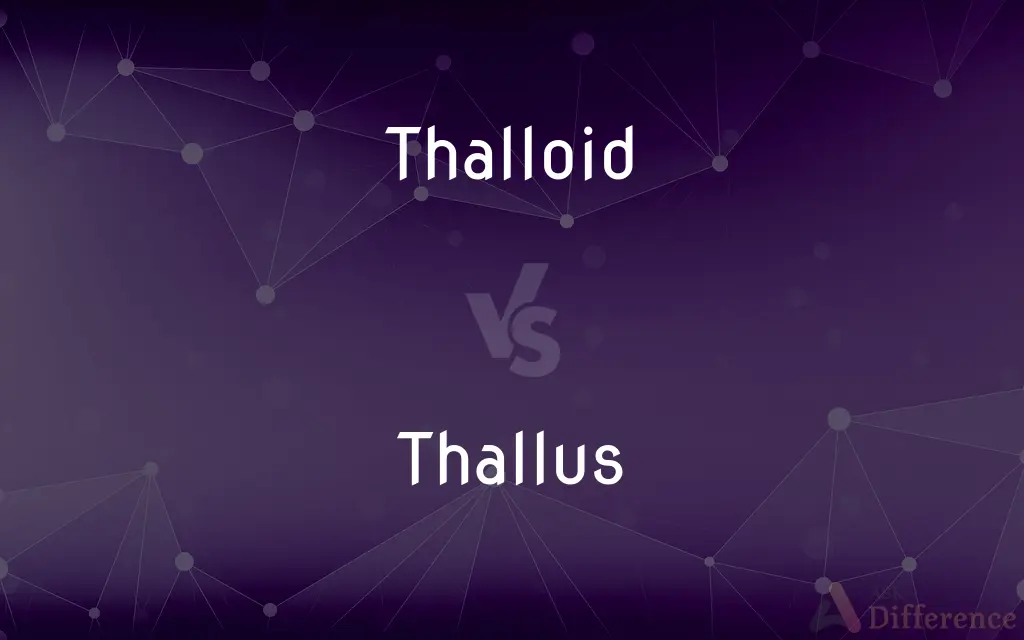Thalloid vs. Thallus — What's the Difference?
By Fiza Rafique & Maham Liaqat — Updated on March 9, 2024
Thalloid refers to a plant or organism resembling a thallus, a simple, undifferentiated structure, while thallus is the actual body of algae, fungi, or non-vascular plants, lacking true stems, roots, or leaves.

Difference Between Thalloid and Thallus
Table of Contents
ADVERTISEMENT
Key Differences
Thalloid organisms exhibit a simple, often flattened structure that lacks the distinct organs found in higher plants. This term is descriptive, used to characterize plants or plant-like organisms that resemble or have the form of a thallus. On the other hand, a thallus is the actual physical structure of certain algae, fungi, lichens, and non-vascular plants such as liverworts and mosses. It serves as the complete body of these organisms, performing photosynthesis, reproduction, and other vital functions.
The term "thalloid" is generally used in a comparative or descriptive sense, implying that an organism has characteristics similar to those of a thallus. For example, certain liverworts are thalloid, meaning they have a flat, leaf-like appearance without true leaves, roots, or stems. Thallus, however, refers specifically to the entity itself, indicating that the organism does not possess or need these differentiated tissues to survive and reproduce.
In terms of complexity, thalloid organisms can vary from very simple to somewhat complex, but they always lack the differentiated organs of higher plants. A thallus, in contrast, may display a range of complexities within its structure, from the relatively simple sheets of algae to the more complex and layered structures found in some lichens and liverworts, yet it remains fundamentally undifferentiated.
While the distinction between thalloid and a thallus might seem nuanced, it highlights the vast diversity of life forms that rely on these simple structures for survival. Both terms emphasize the importance of non-vascular, non-differentiated forms in ecosystems, especially in moist or aquatic environments where these organisms often play key roles.
Comparison Chart
Definition
Resembling or characteristic of a thallus
The body of an organism, usually algae, fungi, or non-vascular plants
ADVERTISEMENT
Complexity
Can vary, always lacks true roots, stems, leaves
Ranges from simple to complex but undifferentiated
Function
Descriptive term, indicating similarity to a thallus
Serves as the complete organism, performing vital functions
Reproduction
May possess simple reproductive structures
Often contains specialized structures for reproduction
Example
Thalloid liverworts
Algae, fungi, lichens, mosses, and liverworts
Compare with Definitions
Thalloid
Resembling a thallus, especially in being undifferentiated.
The thalloid body of the liverwort spreads across the damp rock.
Thallus
Serves as the primary structure of the organism.
The thallus of the lichen was composed of symbiotic algae and fungi.
Thalloid
Used to describe simple organisms or structures.
Thalloid algae form the base of many aquatic ecosystems.
Thallus
The body of non-vascular plants, algae, or fungi.
The thallus of the moss was soft and spongy to the touch.
Thalloid
Lacking true stems, roots, or leaves, similar to a thallus.
Thalloid plants are common in moist habitats where they form green carpets.
Thallus
A structure that performs photosynthesis and reproduction.
The algae's thallus floated freely in the clear pond.
Thalloid
A term indicating morphological simplicity.
The garden was covered in a variety of thalloid greenery.
Thallus
Can be filamentous or sheet-like in form.
The filamentous thallus of the fungus spread through the forest floor.
Thalloid
Sometimes applied to lichens and certain fungi.
The thalloid lichen clung tightly to the tree bark.
Thallus
Lacks differentiation into stems, roots, or leaves.
The liverwort's thallus absorbed moisture directly from its surroundings.
Thalloid
Of, resembling, or constituting a thallus.
Thallus
Thallus (plural: thalli), from Latinized Greek θαλλός (thallos), meaning "a green shoot" or "twig", is the vegetative tissue of some organisms in diverse groups such as algae, fungi, some liverworts, lichens, and the Myxogastria. Many of these organisms were previously known as the thallophytes, a polyphyletic group of distantly related organisms.
Thalloid
Of or pertaining to a thallus.
Thallus
A plant body undifferentiated into stem, root, or leaf.
Thalloid
(botany) Of a plant, alga, or fungus lacking complex organization, especially lacking distinct stems, roots, or leaves.
Thallus
The main body of an alga, fungus, or lichen.
Thalloid
Resembling, or consisting of, thallus.
Thallus
(botany) An undifferentiated plant body, such as in algae.
Thalloid
Of or relating to or resembling or consisting of a thallus
Thallus
(botany) Any plant body lacking vascular tissue.
Thallus
A solid mass of cellular tissue, consisting of one or more layers, usually in the form of a flat stratum or expansion, but sometimes erect or pendulous, and elongated and branching, and forming the substance of the thallogens.
Thallus
A plant body without true stems or roots or leaves or vascular system; characteristic of the thallophytes
Common Curiosities
Are thalloid organisms limited to a specific environment?
Thalloid organisms often thrive in moist or aquatic environments, where their simple structures are advantageous for absorption and reproduction.
Is there a functional advantage to being thalloid?
The simplicity of thalloid organisms allows for efficient absorption of water and nutrients, crucial for survival in their specific habitats.
What distinguishes a thalloid organism from one with a thallus?
Thalloid refers to the resemblance to a thallus, indicating a simple, undifferentiated structure, whereas a thallus is the actual body of certain organisms.
How does the structure of a thallus vary among different organisms?
It varies from simple, flat sheets in algae to more complex, layered structures in lichens and liverworts.
How do scientists classify thalloid organisms?
They are classified based on their reproductive structures, DNA sequences, and ecological roles, among other factors.
How is the health of aquatic ecosystems related to thalloid organisms?
They often indicate the health of aquatic ecosystems through their presence and abundance, serving as bioindicators.
Do thalloid organisms have any commercial uses?
Some are used in food, medicine, and bioindicators for environmental monitoring.
What challenges do thalloid organisms face?
They are sensitive to environmental changes, such as pollution and habitat destruction, which can threaten their survival.
Can all non-vascular plants be described as thalloid?
Many non-vascular plants have thalloid characteristics, but the term specifically applies to those with simple, undifferentiated bodies.
Why is the study of thalloid organisms important?
Understanding these organisms helps scientists learn about evolutionary adaptations, ecosystem dynamics, and potential applications in biotechnology.
What role do thalloid organisms play in ecosystems?
They contribute to biodiversity, serve as primary producers in aquatic ecosystems, and aid in soil formation and stabilization.
Can thalloid organisms be found in dry environments?
While they prefer moist environments, some can survive in dry conditions by entering dormant states.
Can thalloid structures be artificially created for research?
Yes, researchers can cultivate thalloid organisms in controlled environments to study their properties and ecological roles.
Share Your Discovery

Previous Comparison
Heath vs. Moor
Next Comparison
Reservoir vs. PondAuthor Spotlight
Written by
Fiza RafiqueFiza Rafique is a skilled content writer at AskDifference.com, where she meticulously refines and enhances written pieces. Drawing from her vast editorial expertise, Fiza ensures clarity, accuracy, and precision in every article. Passionate about language, she continually seeks to elevate the quality of content for readers worldwide.
Co-written by
Maham Liaqat













































